

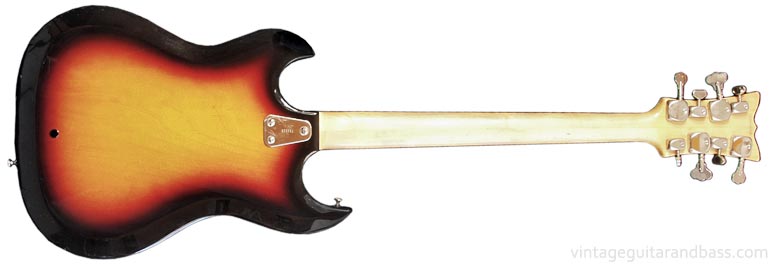
Hagstrom was a Swedish Instrument manufacturer that started out making accordions, and by 1958 was making guitars too, though production finished in the early 1980s. In this time, they made many fine and innovative instruments, played by the likes of David Bowie, Elvis Presley, Brian Ferry and many more.
The H8 was the first eight string bass, and quickly spawned many multi-stringed bass rivals it was only manufactured for a brief period in the late 1960s. The strings were set in pairs, each tuned an octave apart, so it was played like a four string. It is of course possible to tune in 5ths or any other interval. The pole pieces are wider than those on previous Hagstrom bass pickups, to allow for the additional string. In total 2,249 were made, in seven batches of between 100 and 600 instruments between 1967 and 1969.
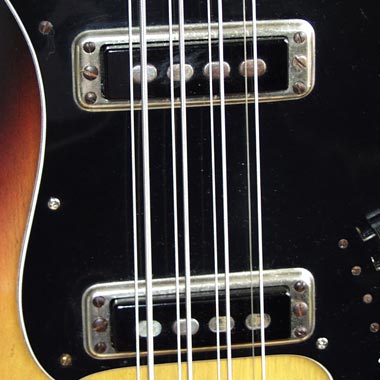
Few instruments are as steeped in rock and roll folklore as the Eight string basses used by Jimi Hendrix and Noel Redding of the Hendrix Experience. The story goes that their bass (or possibly basses) was purchased in America in 1967 whilst the band was on tour. Noel used it on the 1967 album 'Axis Bold as Love' on the tracks Spanish Castle Magic, You've got me Floating and Little miss Lover.
Then came Jimi's turn. After quitting a tour with the Monkees the Experience had a few weeks to kill, so Jimi decided to hang out with his old band Curtis Knight and the Squires. Needless to say, they jammed and recorded some great, and some not so great tracks. The better tracks feature Jimi on guitar with some blinding wah-wah fuelled psychedelia, but he also plays 8-string bass on some tracks (along with some very funky 4 string bass played by the bands regular bassist - Ed 'Bugs' Gregory). Jimi's sound is slightly distorted, and in many ways he fills the role of rhythm guitarist rather than bassist - these tracks can be heard on 'The Summer of Love Sessions. Another album to feature the H-8 was the outstanding 1998 compilation of BBC sessions. It can be clearly heard on the tracks taken from the Alexis Korner 'Rhythm and Blues' show, and is in fact mentioned on the program. The outstanding Hoochie Coochie Man (also featuring Alexis Korner on slide guitar) really benefits from the 8 strings heaviness, and can really be heard in the breakdown just after half way through.
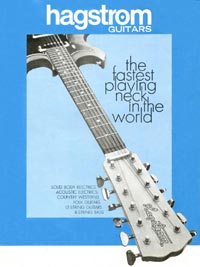
Other users include Billy 'bass' Nelson of Funkadelic, Mike Rutherford (Genesis) on I know what I like, Andy Kulberg of the Blues Project, and Danny McCulloch of Eric Burden and the Animals. If you know of more, please leave a comment.
This is one of those instruments with a really distinctive sound. Full and bassy yet somehow trebly at the same time - that's eight strings for you! The sound is so full, that it can substitute for a bass and rhythm guitar simultaneously - a natural choice for a three piece band. Likewise in a larger band, it can be too much, particularly with more than one guitarist.
Clips below are from two different Hagstrom H8 Eight String Basses - the first two clips are from a 1967 bass fitted with round wound strings, and recorded directly into my sound card; ie no amplifier. The final clip is from a 1969 bass and played through a 1964 Ampeg B15 portaflex amplifier.
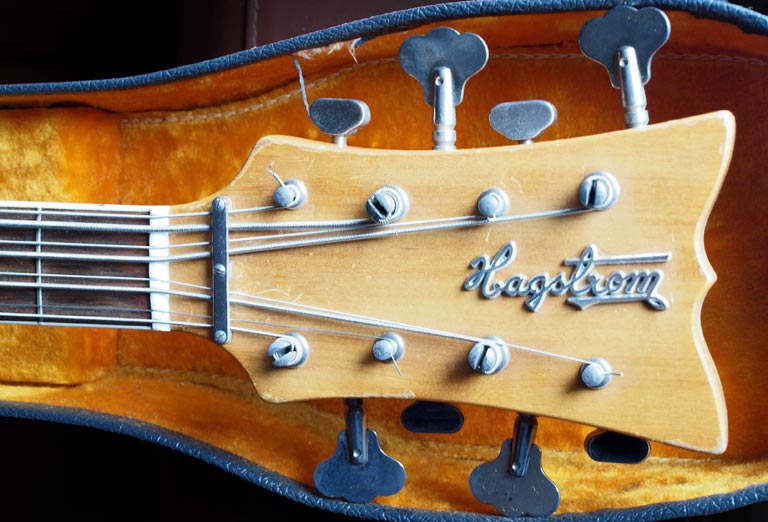
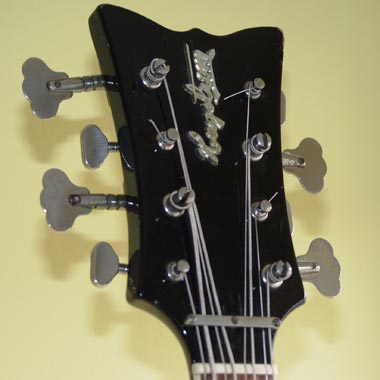
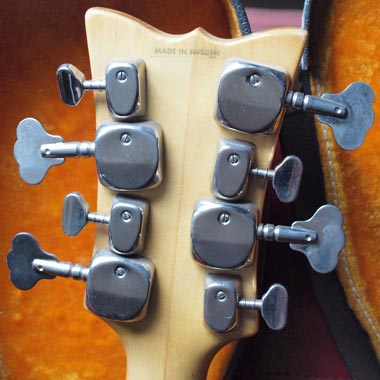
Instruments could be shipped with Natural, Black, Translucent Cherry, or Mahogany Burst headstocks. Note the exaggerated 'open book' headstock profile, somewhat similar to that of a Gibson. The headstock branding is typically a raised plastic scripted Hagstrom logo, although on occasion a decal seems to have replaced this. Tuning keys look somewhat odd - there are actually two different sets of Van Ghent keys - the larger attach to the main bass strings, the smaller (as used in numerous other Hagstrom six strings of the time) attach to the octave strings. Note the 'Made in Sweden' decal at the top reverse of the headstock.
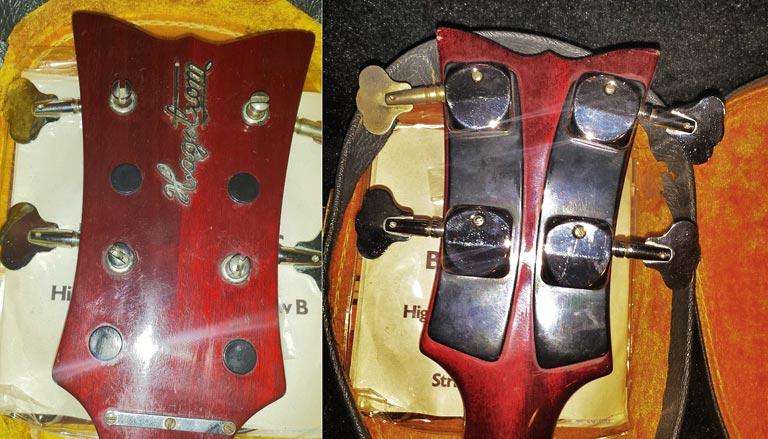
Towards the end of production, the H8 was not selling well and many instruments from later batches were converted to 4 string basses - by blocking off the holes with black plastic plates on the back, as shown above
The Hagstrom Eight String bass is a pretty quirky instrument with some pretty unique sounds. And there are a LOT of tonal possibilities, both from the instruments controls, and the use of unconventional tunings. Strings are in pairs, traditionally tuned in octaves, just like a 12-string guitar. The treble string is positioned directly above, and quite close to, the bass string, and like the 12-string, notes are played together on both strings. It's not impossible to play fingerstyle, but is more effective when played with a pick. Unlike a guitar, chords are not really the name of the game, and as single notes are the focus of most bass lines, downward picks give the most tonal consistency. But you can play just the 'bass' strings if you carefully pick upwards. A typical hard plastic bass pick works ok, but I find you get a better result with a more flexible pick. Thin plastic is ok for playing multiple strings, but I quite like a thick leather pick. These are firm enough to get a decent sound when playing one string, but flexible enough when playing several. They do produce a darker jazzier sound though. The is significant extra footage of this guitar exploring more settings and detailing alternate tunings in the supporting members area.
Find out more about these instruments here: 1968 Hagstrom H8, 1964 Ampeg B-15N
The H8 is traditionally tuned in octaves, but you can also get some very interesting effects using alternate tunings of the treble strings. For more examples of this, check out the long version of this video in the vintageguitarandbass supporting members area.
Recorded here with a Shure SM57 (left channel) and a Heil PR-40 (right channel), through a Focusrite Scarlett 2i2 interface - highly recommended gear!
Find out more about these instruments here: 1968 Hagstrom H8, 1964 Ampeg B-15N
The H8 strings are in pairs - you need to play downstrokes to hit each pair with any degree of uniformity, but you can select just the 'bass' string with careful upstrokes. Check out the long version of this video in the vintageguitarandbass supporting members area.
Recorded here with a Shure SM57 (left channel) and a Heil PR-40 (right channel), through a Focusrite Scarlett 2i2 interface - highly recommended gear!
Find out more about these instruments here: 1968 Hagstrom H8, 1964 Ampeg B-15N
We can get some really bright chiming tones from this bass / amp by selecting just the bridge pickup and picking down by the bridge. Check out the long version of this video in the vintageguitarandbass supporting members area.
Recorded here with a Shure SM57 (left channel) and a Heil PR-40 (right channel), through a Focusrite Scarlett 2i2 interface - highly recommended gear!
Find out more about these instruments here: 1968 Hagstrom H8, 1964 Ampeg B-15N
The Hagstrom Eight String bass (H8, or F800) is a pretty quirky instrument with some pretty unique sounds. And there are a LOT of sound possibilities, both from the instruments controls, and the use of unconventional tunings. Strings are in pairs, traditionally tuned in octaves, just like a 12-string guitar. The treble string is positioned directly above, and quite close to, the bass string, and like the 12-string, notes are played together on both strings. It's not impossible to play fingerstyle, but is more effective when played with a pick. Unlike a guitar, chords are not really the name of the game, and as single notes are the focus of most basslines, downward picks give the most tonal consistency. But you can play just the 'bass' strings if you carefully pick upwards. A typical hard plastic bass pick works ok, but I find you get a better result with a more flexible pick. Thin plastic is ok for playing multiple strings, but I quite like a 'Leather Tones' leather guitar pick. These are firm enough to get a decent sound when playing one string, but flexible enough when playing several. They do produce a darker jazzier sound though. Hear the difference in the video.
You can also get some very interesting effects using alternate tunings of the treble strings; typically uptuning these by a 3rd or a 5th. Again, hear some of these sounds towards the end of the video.
Recorded here with a Shure SM57 (left channel) and a Heil PR-40 (right channel), through a Focusrite Scarlett 2i2 interface - highly recommended gear!